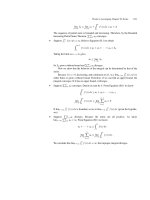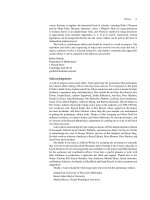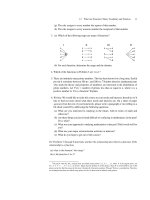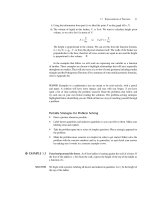Morphology, functions and potential application of T Lymphocytes
Bạn đang xem bản rút gọn của tài liệu. Xem và tải ngay bản đầy đủ của tài liệu tại đây (4.95 MB, 36 trang )
Morphology, functions and potential
application of T Lymphocytes
GROUP 3
Outline
•Introduction
•Morphology of T Lymphocyte
•Functions of T Lymphocyte
•Potential application of T Lymphocytes
Introduction
T lymphocyte is a type of lymphocyte (a subtype of white blood cell) that
plays a central role in cell-mediated immunity
In this immunofluorescence image, a cytotoxic T cell
(blue). A patch of signaling molecules (pink). Lytic
granules (red), the microtubule cytoskeleton (green)
Scanning electron micrograph of a human
T lymphocyte (also called a T cell) from the
immune system of a healthy donor. Credit:
NIAID
Morphology of T Lymphocytes
•T-Lymphocytes are a type of white blood cells that play a
role in cell-mediated immunity.(1)
•Blood T and B lymphocytes are indistinguishable by light
and electron microscopy
•The difference between T lymphocytes and B lymphocytes
are difference of diameter.
Morphology of T Lymphocytes
•T cells are about 7-8 micrometers
•Small amount of light blue cytoplasm
•Coarsely clumped chromatin
•Nucleus is round oval in shape
Morphology of T Lymphocytes
The surface of each T cell also displays thousands of
identical T cell receptors (TCRs).
There are two types of T cells that differ in their TCR:
◦ Alpha/beta (αβ) T cells
◦ Gamma/delta (γδ) T cells
Morphology of T Lymphocytes
Alpha/beta (αβ) T cells.
Their TCR is a heterodimer of an
alpha chain with a beta chain
Morphology of T Lymphocytes
Gamma/delta (γδ) T cells.
Their TCR is also a
heterodimer of a gamma
chain paired with a delta
chain.
Morphology of T Lymphocytes
Most of the T cells in the body belong to one of
two subsets. These are distinguished by the
presence on their surface of one or the other of
two glycoproteins designated:
• CD4
• CD8
Morphology of T Lymphocytes
CD8+T cell
CD4+T cell
DR.TV.Rao MD
Types Of T Cells
Helper T cells.
Suppressor T cells.
Cytotoxic T cells.
Memory T cells.
Helper T Cells
Also known as CD4+ T cells.
¾ of T cells.
Two major types: Th1 and Th2.
Helper T Cells
Stimulation of cytotoxic and suppressor T cells.
Stimulation of B cells’ growth, differentiation
to form plasma cell clones. (Th1)
Activation of Macrophage system. (Th2)
Feedback stimulation effect on themselves.
Helper cells that
have not become
activated.
Helper T Cells
Cytotoxic T cells and B cells cannot react to the
antigens without the “permission” of helper T
cells.
Suppressor T Cells
Also known as regulatory T cells.
Suppress function of cytotoxic and helper T cells.
→ shut down (turn off) those immune system
cells when an infection has been brought under
control.
Suppressor T Cells
Prevent the excessive damge to the healthy
surrounding tissue.
→Prevent damage to body itself.
→Immune tolerance.
Regulatory cells along with helper cells.
Cytotoxic T Cells
•CD8-cytotoxic T cell: killer cell
•Direct attack on infected cell
•Perforin: hole-forming protein
•Destroying cancer cells; heart
transplant cells or other cells
foreign to body
Cytotoxic T Cells
Recognition
/>
Cytotoxic T Cells
Activation
Cytotoxic T Cells
Releasing perforin
and granzyme
Perforin
Cytotoxic T Cells
Forming of perforin on
surface of infected cell
Cytotoxic T Cells
Hole-forming and entering of
granzyme
Cytotoxic T Cells
Cell death
Memory T cells
To be activated by antigens but do not enter in circulation,
remain in lymphoid organs
A small fraction of active CD8+ T cell persist to generate pool
of a long-lived memory.
Self-renew and protect against infection.
The basis of vaccination.









